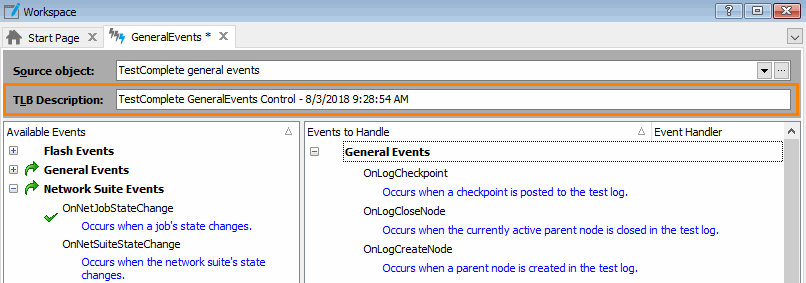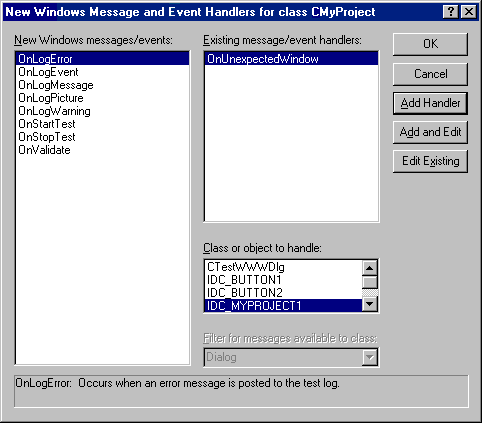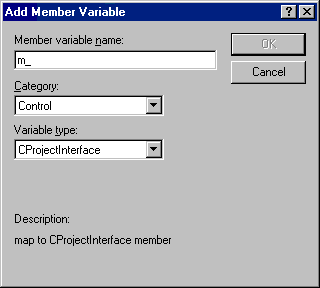 |
Information in this topic applies to generic desktop applications (.NET, WPF, Delphi and others). |
 |
Connected and Self-Testing applications are deprecated. These technologies will be removed in one of the future releases of TestComplete. To create test code that runs from within your tested apps, use TestLeft, a SmartBear functional testing tool for developers. |
To handle events in TestComplete, you use Event controls. These controls are ActiveX objects registered in the operating system. You can use them to create event handlers in TestComplete, as well as in any other application that supports working with ActiveX controls. This topic explains how you create handling code for TestComplete events in C++ Connected Applications.
1. Preparing the Event Control
Before you start creating event handlers, you need to prepare the Event control that you will use for event handling.
-
Open your test project in TestComplete, and open your Event control for editing. To do this, right-click the Event control in the Project Explorer and choose Edit from the context menu.
-
In the Event Control editor, add the desired events to the Event control. The steps you need to perform depend on the events to be handled. See Adding Events to Event Controls for complete information.
-
In the TLB Description edit box at the top of the Event Control editor, specify some descriptive text for your Event control. This text will identify the control among other ActiveX objects in the system.

-
Select File | Save from the TestComplete main menu to save the changes.
2. Adding the Event Control to a Form
In order to handle events in your Visual C++ application, you need to add the Event control to a Visual C++ form:
-
Open your Visual C++ project in Visual Studio.
-
Right-click the desired form in Visual C++ and select Insert ActiveX Control from the context menu. The Insert ActiveX Control dialog will appear.
-
The ActiveX Controls box of the dialog lists all ActiveX components registered in the operating system. Search for the
Eventcontrol using the description you have specified in the TLB description field of the Event Control editor.When the control is found, select it and press OK. The control will be added to the form.
3. Creating Event Handling Code
3.1. Creating the Event Handler Function
-
To create an event handler, right-click the control on the form and select Event from the context menu. This will call the New Windows Message and Event Handlers dialog.

-
Select the desired event in the New Windows messages/events list and press Add Handler. Visual C++ will ask you for the name of the event handler procedure and then add it to the form.
To change its code, select the event handler in the Existing message/event handlers list and press Edit Existing.
-
To refer to the
Eventcontrol from code, you should create a member variable for it:-
Select the EventControl ID in the Control IDs list of the New Windows Message and Event Handlers dialog.
-
Press Add Variable. The Add Member Variable dialog will appear.

-
In the dialog, specify the variable name, category, type and then press OK.
-
3.2. Attaching Event Controls to Event Sources
To make your Event control respond to events of TestComplete or ActiveX objects, you should establish a link between the control and TestComplete (or between the control and the desired object). We call this attaching an Event control to the event source. You should attach the control to every object, whose events you are going to handle. The Event control can only process the TestComplete engine’s events or events of an ActiveX object if it has been attached to them.
To attach an Event control to TestComplete or desired object, use the following methods of the Event control:
-
EventControl.AttachToTestComplete()- Establishes the link to the TestComplete engine. Call this method if you need to handle TestComplete events. -
EventControl.AttachTo(Obj)- Attaches the Event control to any object specified by the Obj parameter. This object must implement theIDispatchinterface. Use this methods to handle events of ActiveX objects that reside outside of TestComplete.Note: The AttachTomethod is available if your Event control contains events of external ActiveX objects. If the control only contains TestComplete events, the method is unavailable.
It may be convenient to attach an Event control to the desired event source after your C# Connected Application has been started. You can call the AttachToTestComplete and AttachTo methods within the OnLoad event handler of the application’s main form. For instance, to handle events of the Document object of Microsoft Word, follow these steps:
-
Add Microsoft Word’s events to the list of project events. See Adding Events to Event Controls for more information on this.
-
Attach the Event control to TestComplete by calling the
EventControl.AttachToTestCompletemethod. -
Attach the Event control to each Microsoft Word’s Document object, whose events you would like to handle. That is, call
EventControl.AttachTo(DocumentObject)for each Document object:Visual C++
OleInit ole;
...
var WordAppObject, DocObject1, DocObject2;
...
// Attaching to TestComplete
m_EventControl.AttachToTestComplete();
// Getting references to Microsoft Word and Document objects
WordAppObject = Sys["OleObject"]("Word.Application");
DocObject1 = WordAppObject["Documents"]["Item"](1);
DocObject2 = WordAppObject["Documents"]["Item"](2);
// Attaching to Microsoft Word and Document objects
m_EventControl.AttachTo(WordAppObject);
m_EventControl.AttachTo(DocObject1);
m_EventControl.AttachTo(DocObject2);Note: Here m_EventControlis a member variable for theEventcontrol.
3.3. Detaching Event Controls From Event Sources
When the testing is over, it is recommended to detach from the objects whose events were processed. This will prevent you from possible malfunction in the application under test and in the system.
To detach from TestComplete, call the EventControl.DetachFromTestComplete method. To detach from other objects, call EventControl.DetachFrom(Obj):
Visual C++
var WordAppObject, DocObject1, DocObject2;
...
// Attaching Event control to event sources
m_EventControl.AttachToTestComplete();
m_EventControl.AttachTo(WordAppObject);
m_EventControl.AttachTo(DocObject1);
m_EventControl.AttachTo(DocObject2);
...
// Test code
...
// Detaching Event control from event sources
m_EventControl.DetachFrom(WordAppObject);
m_EventControl.DetachFrom(DocObject1);
m_EventControl.DetachFrom(DocObject2);
m_EventControl.DetachFromTestComplete();
The DetachFrom method is available only if your Event control contains some events of external ActiveX objects. It is not available if the control contains only TestComplete events.
 |
After the Event control has been detached from TestComplete or an object, it will not receive notifications about events that occur in TestComplete or this object, thus you will not be able to handle these events. |
See Also
Handling Events - Overview
Creating Event Handlers for External COM Objects
Creating Connected Applications in C++
Creating Event Handlers in Connected Applications

 1. Preparing the Event Control
1. Preparing the Event Control